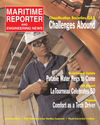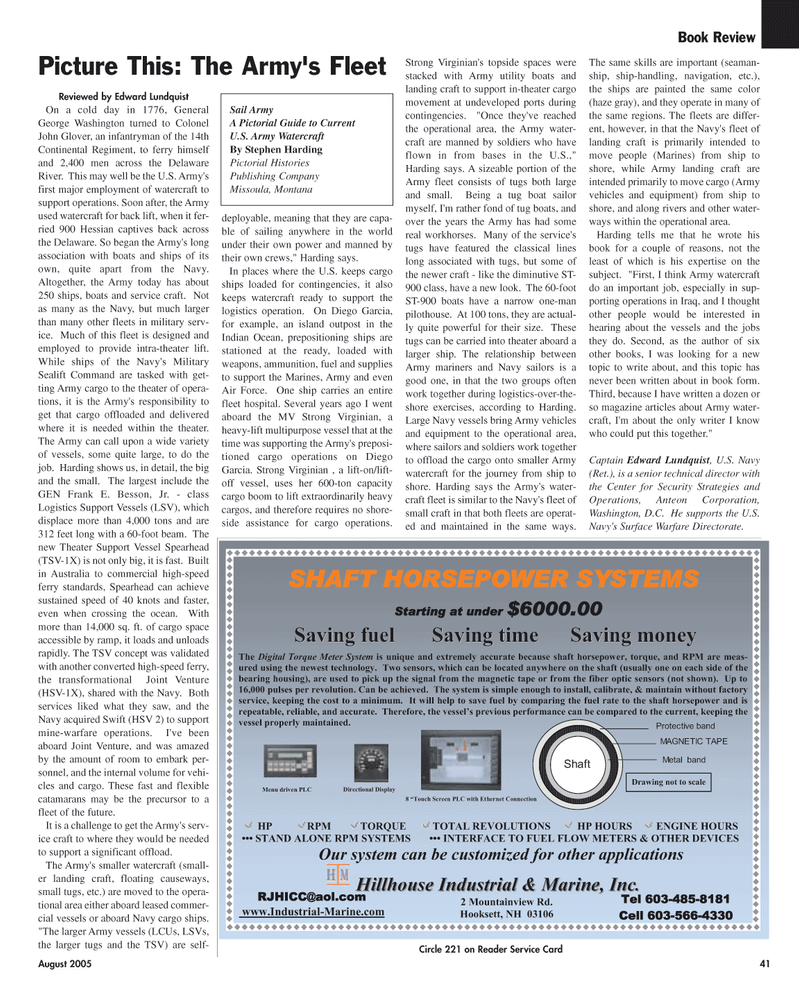
Page 41: of Maritime Reporter Magazine (August 2005)
AWO Edition: Inland & Offshore Waterways
Read this page in Pdf, Flash or Html5 edition of August 2005 Maritime Reporter Magazine
August 2005 41
Reviewed by Edward Lundquist
On a cold day in 1776, General
George Washington turned to Colonel
John Glover, an infantryman of the 14th
Continental Regiment, to ferry himself and 2,400 men across the Delaware
River. This may well be the U.S. Army's first major employment of watercraft to support operations. Soon after, the Army used watercraft for back lift, when it fer- ried 900 Hessian captives back across the Delaware. So began the Army's long association with boats and ships of its own, quite apart from the Navy.
Altogether, the Army today has about 250 ships, boats and service craft. Not as many as the Navy, but much larger than many other fleets in military serv- ice. Much of this fleet is designed and employed to provide intra-theater lift.
While ships of the Navy's Military
Sealift Command are tasked with get- ting Army cargo to the theater of opera- tions, it is the Army's responsibility to get that cargo offloaded and delivered where it is needed within the theater.
The Army can call upon a wide variety of vessels, some quite large, to do the job. Harding shows us, in detail, the big and the small. The largest include the
GEN Frank E. Besson, Jr. - class
Logistics Support Vessels (LSV), which displace more than 4,000 tons and are 312 feet long with a 60-foot beam. The new Theater Support Vessel Spearhead (TSV-1X) is not only big, it is fast. Built in Australia to commercial high-speed ferry standards, Spearhead can achieve sustained speed of 40 knots and faster, even when crossing the ocean. With more than 14,000 sq. ft. of cargo space accessible by ramp, it loads and unloads rapidly. The TSV concept was validated with another converted high-speed ferry, the transformational Joint Venture (HSV-1X), shared with the Navy. Both services liked what they saw, and the
Navy acquired Swift (HSV 2) to support mine-warfare operations. I've been aboard Joint Venture, and was amazed by the amount of room to embark per- sonnel, and the internal volume for vehi- cles and cargo. These fast and flexible catamarans may be the precursor to a fleet of the future.
It is a challenge to get the Army's serv- ice craft to where they would be needed to support a significant offload.
The Army's smaller watercraft (small- er landing craft, floating causeways, small tugs, etc.) are moved to the opera- tional area either aboard leased commer- cial vessels or aboard Navy cargo ships. "The larger Army vessels (LCUs, LSVs, the larger tugs and the TSV) are self- deployable, meaning that they are capa- ble of sailing anywhere in the world under their own power and manned by their own crews," Harding says.
In places where the U.S. keeps cargo ships loaded for contingencies, it also keeps watercraft ready to support the logistics operation. On Diego Garcia, for example, an island outpost in the
Indian Ocean, prepositioning ships are stationed at the ready, loaded with weapons, ammunition, fuel and supplies to support the Marines, Army and even
Air Force. One ship carries an entire fleet hospital. Several years ago I went aboard the MV Strong Virginian, a heavy-lift multipurpose vessel that at the time was supporting the Army's preposi- tioned cargo operations on Diego
Garcia. Strong Virginian , a lift-on/lift- off vessel, uses her 600-ton capacity cargo boom to lift extraordinarily heavy cargos, and therefore requires no shore- side assistance for cargo operations.
Strong Virginian's topside spaces were stacked with Army utility boats and landing craft to support in-theater cargo movement at undeveloped ports during contingencies. "Once they've reached the operational area, the Army water- craft are manned by soldiers who have flown in from bases in the U.S.,"
Harding says. A sizeable portion of the
Army fleet consists of tugs both large and small. Being a tug boat sailor myself, I'm rather fond of tug boats, and over the years the Army has had some real workhorses. Many of the service's tugs have featured the classical lines long associated with tugs, but some of the newer craft - like the diminutive ST- 900 class, have a new look. The 60-foot
ST-900 boats have a narrow one-man pilothouse. At 100 tons, they are actual- ly quite powerful for their size. These tugs can be carried into theater aboard a larger ship. The relationship between
Army mariners and Navy sailors is a good one, in that the two groups often work together during logistics-over-the- shore exercises, according to Harding.
Large Navy vessels bring Army vehicles and equipment to the operational area, where sailors and soldiers work together to offload the cargo onto smaller Army watercraft for the journey from ship to shore. Harding says the Army's water- craft fleet is similar to the Navy's fleet of small craft in that both fleets are operat- ed and maintained in the same ways.
The same skills are important (seaman- ship, ship-handling, navigation, etc.), the ships are painted the same color (haze gray), and they operate in many of the same regions. The fleets are differ- ent, however, in that the Navy's fleet of landing craft is primarily intended to move people (Marines) from ship to shore, while Army landing craft are intended primarily to move cargo (Army vehicles and equipment) from ship to shore, and along rivers and other water- ways within the operational area.
Harding tells me that he wrote his book for a couple of reasons, not the least of which is his expertise on the subject. "First, I think Army watercraft do an important job, especially in sup- porting operations in Iraq, and I thought other people would be interested in hearing about the vessels and the jobs they do. Second, as the author of six other books, I was looking for a new topic to write about, and this topic has never been written about in book form.
Third, because I have written a dozen or so magazine articles about Army water- craft, I'm about the only writer I know who could put this together."
Captain Edward Lundquist, U.S. Navy (Ret.), is a senior technical director with the Center for Security Strategies and
Operations, Anteon Corporation,
Washington, D.C. He supports the U.S.
Navy's Surface Warfare Directorate.
Book Review
SHAFT HORSEPOWER SYSTEMS Starting at under $6000.00 Saving fuel Saving time Saving money
The Digital Torque Meter System is unique and extremely accurate because shaft horsepower, torque, and RPM are meas- ured using the newest technology. Two sensors, which can be located anywhere on the shaft (usually one on each side of the bearing housing), are used to pick up the signal from the magnetic tape or from the fiber optic sensors (not shown). Up to 16,000 pulses per revolution. Can be achieved. The system is simple enough to install, calibrate, & maintain without factory service, keeping the cost to a minimum. It will help to save fuel by comparing the fuel rate to the shaft horsepower and is repeatable, reliable, and accurate. Therefore, the vessel’s previous performance can be compared to the current, keeping the vessel properly maintained.
Hillhouse Industrial & Marine, Inc.
[email protected] www.Industrial-Marine.com HP RPM TORQUE TOTAL REVOLUTIONS HP HOURS ENGINE HOURS ••• STAND ALONE RPM SYSTEMS ••• INTERFACE TO FUEL FLOW METERS & OTHER DEVICES Our system can be customized for other applications
Tel 603-485-8181
Cell 603-566-4330
Menu driven PLC Shaft Protective band
MAGNETIC TAPE
Metal band 2 Mountainview Rd.
Hooksett, NH 03106
Drawing not to scale 8 “Touch Screen PLC with Ethernet Connection
Directional Display
Circle 221 on Reader Service Card
Picture This: The Army's Fleet
Sail Army
A Pictorial Guide to Current
U.S. Army Watercraft
By Stephen Harding
Pictorial Histories
Publishing Company
Missoula, Montana
MR AUGUST 2005 #6 (41-48).qxd 8/4/2005 9:08 PM Page 41

 40
40

 42
42
